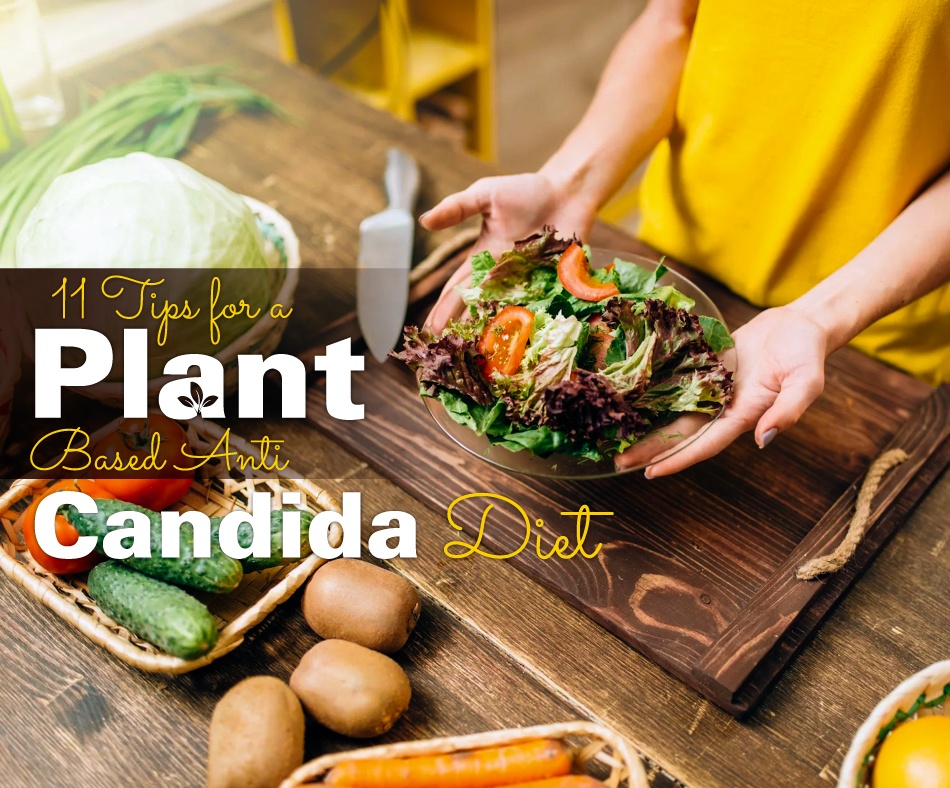What is Candida?
Candida Albicans, is essentially a fungus-like organism that normally lives in the large intestine. Candida is always present in the intestine and is necessary for breaking down the food and digesting it.
However, when there’s an overgrowth of candida, that’s why it can cause and/or aggravate conditions like Crohn’s disease, poor memory, head, headache, and ulcerative colitis.
Candida albicans overgrowth can also affect myriad other body parts causing oral thrush, infection of the genitals, throat, and mouth.
Other than medication, it is highly recommended that you try a good Candida diet. The goal of one such diet is to cut back on certain foods that might be aggravating/causing the issue while focusing on the foods that fight candida overgrowth.
Candida on a Vegan Diet
As we already mentioned, Candida exists naturally inside the human body. And, it has to coexist with trillions of other bacteria, viruses, and microorganisms. Collectively, this microflora is what keeps the gut healthy.
But, due to factors like hectic lifestyle, poor diet, poor sleep, and stress, candida can start overgrowing. It can spread to other body parts and even enter the bloodstream.
The thing is, your liver has to clear out a ton of toxins. But, when the liver has to do so much work, it can cause a lot of health issues. The most common one is higher levels of inflammation.
Therefore, to reverse the condition, you have to work out ways in which to completely alter the gut microflora. To reverse the candida overgrowth totally, you have to makeover your diet. And, there’s nothing more powerful to achieve that goal than a plant-based diet.
If you can find a way to prepare your meals, nothing can be more powerful than a plant-based vegan diet to quicken your recovery.
In this post, we look at some super-important tips to follow if you are on a plant-based candida cleanse and diet.
Include Antifungal Foods in Your Diet
All antifungal foods are excellent for killing off candida overgrowth. Ideally, you should wait at least a week after having started the diet before including antifungal foods. This is to avoid experiencing rather unpleasant and highly uncomfortable candida diet-off symptoms.
The most popular and natural antifungal foods are – cinnamon, aloe vera, around 3 cloves of garlic every day, coconut oil, olive leaf extract, grapefruit seed extract, lemon juice, lime juice, onions, cayenne pepper, pumpkin seeds, olive oil, seaweed, turmeric, and rutabaga.
Consume a Lot of Plant-based Proteins & Fats
Just because you’re on a no-meat diet, doesn’t mean that you cannot get enough proteins from a plant-based diet. In fact, this is not the time to avoid proteins. It’s a good idea to include things like tofu, lentils, chickpeas, kidney beans, garbanzo beans, spirulina, quinoa, almonds, and chia seeds in your meals.
All of these foods will not only keep you satiated for longer periods of time, but they also nourish the cell membranes with essential fatty acids. Those fatty acids are good for fending off candida.
Good Fats & Oils
Some nutrients are only fat-soluble. That means you need healthy fats for energy production as well as for nourishing the cell membranes. Besides, fatty food always tastes better as well. The human brain is made of 60% fat. There’s no question that your body needs fat to keep functioning properly.
The good thing is, on a plant-based diet, you can consume healthy fats. Take coconut oil, for instance. It’s rich in lauric and caprylic acid; both of which are extremely potent antifungals.
Avocado oil, olive oil, and coconut oil are all great cooking ingredients. You can use them in a lot of beverages and meals. Coconut oil, in particular, is great for cooking. It does not oxidize and also has a higher smoke point.
Nuts, seeds, and avocados are other tasty yet healthy options to include in your meals.
It’s always good to drizzle your salad with avocado and olive oil for that added layer of flavour.
Stick with a Low Glycemic Index Meals
In general, it’s a good practice to consume meals that are low on the glycemic index. The idea is to avoid sudden blood sugar spikes. However, maintaining a low-glycemic diet doesn’t mean that you have to entirely forgo legumes and grains.
But, it would be better if you only consume them once a day in limited quantities. In this way, you will not be feeding the candida. Whole grains and other grains like buckwheat, quinoa, teff, and millet are also low glycemic foods. None of them will spike your blood sugar levels.
Also, legumes and beans are rich in carbs and proteins. That means, they digest slowly which is always better than consuming plain carbs.
Besides, if you can incorporate protein, fibre, and fat in your snacks and meals, you will have an easier time maintaining your blood sugar levels.
Don’t Forget to Include Nuts & Seeds
With the exception of peanuts and pistachios; it’s largely safe to consume almost all other seeds and nuts. However, you should always look out for any allergens. Most seeds and nuts are permitted on an anti-candida diet.
But, always aim for unsweetened and natural ones; not those processed ones. You can also include seed butter such as tahini which is essentially the butter of sesame seeds.
These butter are loaded with nutritional value. They are also loaded with healthy fats and proteins. For better digestibility, it’s better if you soak raw seeds and nuts in water overnight. Rinse and drain them before consuming.
Low-Sugar Fruits
Fruits are something that all nutritionists recommend. However, when you’re on a candida diet, you should avoid consuming too many sugary fruits, according to Eric Bakker. Fruits that are too sweet can cause blood sugar spikes which is not good for anyone struggling with candida.
Some of the best low-sugar fruits are – raspberries, kiwis, avocado, grapefruits, watermelons, blackberries, and strawberries.
Do Include Your Favorite Foods
One of the biggest reasons most people slip up or fail while on a diet is because they put too many restrictions. They fail to incorporate their favourite delicious and healthy foods. The truth is – if you want to ensure sustainability – you have to give yourself some room for cheat meals as well.
To that end, you can try things like smoothies, fries, hummus, kale salad, and a few desserts as well. Only then you can maintain a successful diet.
The only way to avoid feeling like you’re making a huge sacrifice or that sense of deprivation is to consume delicious foods and not think necessarily about their nutritional value all the time.
Include Non-starchy Veggies
It’s important that you consume as many non-starchy vegetables as possible. This should not be a problem as we have myriad choices to pick from.
Your choices are – broccoli, avocado, asparagus, cauliflower, cabbage, Brussel sprouts, eggplant, cucumber, celery, raw garlic, green beans, onions, leeks, tomatoes, olives, zucchini, swiss chard, etc.
Additionally, vegetables like turnip and rutabaga are not only starchy but powerfully antifungal as well. So, include those too.
Eat Probiotic Foods and Supplements
Probiotic foods are loaded with live enzymes and microorganisms. When fermented, they turn things like milk into cheese and yoghurt or cabbage and radish into kimchi.
When you consume these fermented foods – you’re essentially increasing the population of healthy microorganisms. This helps to restore balanced gut flora.
Below are some of the popular and healthiest plant-based probiotic foods to pick from –
- Kimchi
- Sauerkraut
- Kombucha
- Picked vegetables
- Water kefir
- Coconut kefir
- Miso
Include Prebiotics in your diet
Prebiotics are a little different from probiotics. These are not fermented foods. Instead, they are generally good for gut health.
They work by feeding the gut microorganisms. But, since they feed good and pathogenic bacteria in the same way, you should be careful with the amount that you consume.
Below are some of the choicest vegan prebiotic foods to pick from –
- Dandelion greens
- Raw chicory root
- Jerusalem artichoke
- Onion
- Leeks
- Asparagus
- Garlic
Chicory root is a great prebiotic option as it contains inulin. You can use almond milk and chicory root to make anti-candida coffee. Be sure to go for unsweetened, non-GMO soy milk. You can use monk fruit extract or stevia to sweeten the beverage.
Don’t Forget to Exercise
Regular exercise and physical activity keep your gut health in shape. It helps the body to get rid of toxins. It is better if you stick with some light exercises only. But, the key is to exercise on a daily basis.
There’s nothing like physical activity to boost the process of natural detoxification. Your immune system will also thank you for getting up and moving around. Let’s not forget, exercise also keeps stress levels at bay.
Bottom Line
If you can maintain a candida diet for a sufficient amount of time, not only will you reverse Candida, but you can get rid of myriad other health problems as well. It’s important to take things slow. Take baby steps and don’t forget to persevere.
It should not take you more than a week or two to successfully reverse candida overgrowth.

